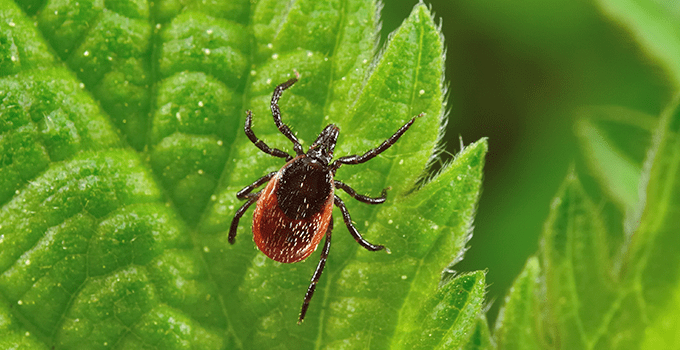
Tick Season Comes To Topeka
7/6/2018
In our Topeka service area, ticks are a serious concern, especially in the summer months when warmth and humidity allow ticks to be more active. Ticks are linked to some diseases that can have lifelong medical implications. Since it’s been awhile since we’ve talked about tick control strategies, let’s talk about prevention as it relates to the specific ticks that are common in Topeka, and what health threats these ticks are linked to.
Blacklegged Ticks
This tick species, also referred to as a deer tick, grows to only about 1/8th of an inch in length. It is brownish-orange and has dark colored legs. Because it is so small, it can be brought into your yard on tiny mammals, like rodents and birds, which can present a serious issue. Rodents can bring blacklegged ticks into your home and spread them around inside. Birds can fly them into your yard and distribute them in locations your pets (and wildlife) can pick them up. For these reasons, blacklegged tick infestations are hard to fight, even though they cannot complete their entire life cycle inside a home.
These ticks are known for spreading Lyme disease, which is incurable in its later stage. While Lyme disease has a dense distribution in the Northeast, cases of Lyme have been reported here.
Control tips: Keep bird feeders away from your home. Seal exterior walls to prevent rodents and other wildlife from getting in.
Lone Star Ticks
Known for the spot on its back, which led to it being named the Lone Star tick, this tick ranges in size from 1/6 of an inch to 1/4 of an inch. It has an oval, flattened body when it is not engorged. While blacklegged ticks have been given the name “deer” tick, it is actually more appropriately applied to this tick which takes white-tailed deer as its key host. Wild turkeys are also a common host.
Lone Star ticks are growing in notoriety because of their link to alpha-gal allergy, also called the red meat allergy, even though it is not exclusive to red meat. This is a lifelong affliction that can create serious medical issues for those who suffer with it.
Control tips: Install fencing around your property to keep wildlife out. Put exterior trash in sealed containers, and clean those containers routinely.
American Dog Ticks
What’s in a name? Quite a bit, actually. The American dog tick gets its name because it prefers domestic dogs as a host. If you find one of these ticks on your dog, it is likely to be engorged, and look a little bit like a big, grayish boil with legs. Ticks of this species that are not partaking in a blood meal are about 3/16 of an inch long and tannish-brown in color with white or yellow markings. Since American dog ticks have an affinity for dogs, pet owners are at greater risk for exposure to these ticks.
While dog ticks don’t prefer humans, they will bite when they get into your home. The illness that you should be concerned about most with this species of ticks is Rocky Mountain spotted fever, which is not restricted to the Rocky Mountain region. It has a wide distribution in the U.S.
Control tips: Create a play area for your dog, to prevent wildlife from coming into that area (with ticks), and to restrain your dog from going into areas around your home where ticks hide. Get veterinarian-prescribed tick products. Stay away from tall grass and wooded areas when you go for a walk with your dog.
General Diseases
The 6 big illnesses spread by ticks are Lyme, Rocky Mountain spotted fever (RMSF), anaplasmosis, ehrlichiosis, babesiosis, and tularemia. These can cause a wide range of symptoms. Early onset symptoms may include a headache, muscles aches, lethargy, fever, stomach aches, rashes, etc. Latter symptoms or severe symptoms can lead to paralysis and even death.
Professional Tick Control
No home should be without routine tick treatments. The reduction of ticks and the control of rodents is essential for the health of family. For assistance with your pest control needs, give us a call today for a free inspection.









